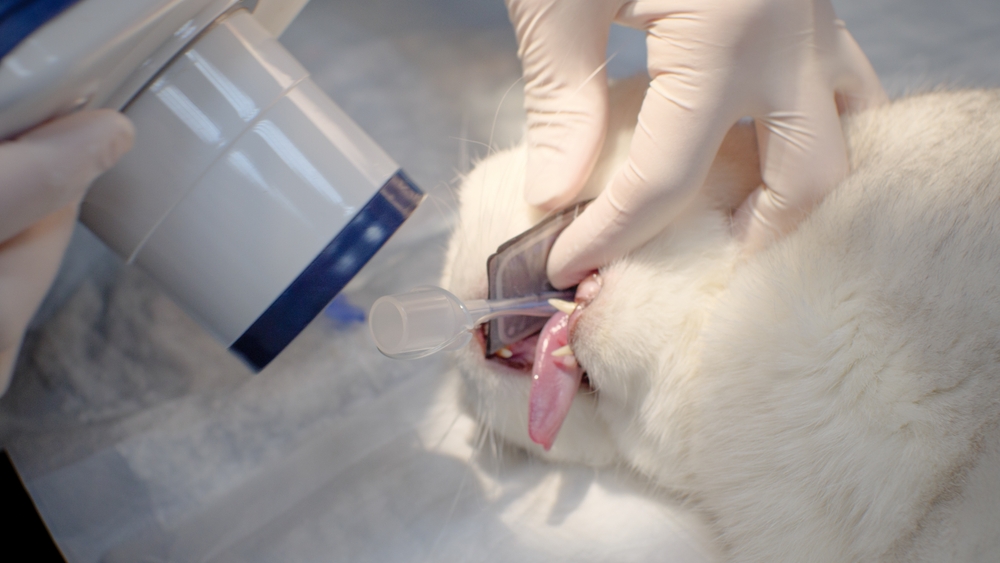In the realm of veterinary medicine, ensuring your pet’s oral health is paramount. While physical inspections give an external view, dental X-rays offer a more comprehensive insight into your pet’s oral structure and health. At Happy Tails Animal Hospital, with Dr. Mann at the helm, we utilize advanced dental X-ray techniques to get a clear picture of what’s happening beneath the surface.
Symptoms Indicating the Need for Dental X-Rays
- Persistent bad breath
- Chewing on one side of the mouth or difficulty eating
- Swelling or pain around the mouth area
- Loose or missing teeth
- Discoloration or noticeable damage to teeth
The Imperative Role of Dental X-Rays in Pet Healthcare
Dental X-rays, in the realm of veterinary medicine, have emerged as a vital tool for obtaining a comprehensive view of a pet’s oral health. These radiographic images provide invaluable details that go beyond what the eye can see, delving below the gumline. They effectively highlight the roots’ health, the jawbone’s condition, and uncover any concealed dental anomalies that might otherwise remain undetected.
Moreover, early detection of potential issues is one of the primary benefits of dental X-rays. Problems such as tooth resorption and bone loss can be pinpointed at their inception, paving the way for prompt and appropriate treatment. In instances where dental surgeries are needed, these X-rays act as a precise guide, aiding in meticulous planning and execution. Furthermore, post any significant dental procedure, X-rays play a critical role in post-treatment assessment, ensuring that everything aligns well and has settled or healed as intended.
Treatment Process
- Initial Examination: Dr. Mann starts with a preliminary assessment to determine the need for an X-ray and pinpoint specific areas of interest.
- Sedation: Recognizing the challenges pets might face staying still, a mild sedation is administered to ensure their comfort and to obtain clear, undistorted X-ray images.
- Preparation: Once the pet is calm and sedated, they’re positioned appropriately for the X-ray. This preparation ensures that the most accurate images are captured, providing a comprehensive view of the dental structure.
- Taking the X-Ray: With state-of-the-art radiography equipment, detailed dental X-rays are captured, shedding light on the health of the teeth, jawbone, and at times, the broader cranial structure.
- Analysis: Post radiography, Dr. Mann, accompanied by the experienced team, meticulously reviews the images, identifying any dental irregularities or potential concerns.
- Post-Procedure Discussion: Upon analysis, Dr. Mann will convene with you to discuss the X-ray findings in depth, charting out any recommended treatments or follow-up care to ensure your pet’s optimal dental health.
Promoting Lifelong Oral Health in Pets
Regular veterinary check-ups are the foundation of a proactive approach to your pet’s oral health. Such consistent dental examinations not only allow for early detection of potential issues but also ensure that minor problems don’t escalate into severe conditions. These visits to the vet serve as the first line of defense, ensuring that our furry friends have the best chance at maintaining a healthy mouth throughout their lives.
At home, pet owners have a pivotal role in maintaining their pet’s oral hygiene. Simple practices, such as brushing their teeth and offering them dental chews, can significantly deter the onset of dental issues. Moreover, a pet’s diet plays a consequential role in their oral well-being. Feeding them a balanced diet rich in essential nutrients fortifies their teeth and gums, bolstering their defenses against potential dental complications.
The Long-Term Benefits of Dental X-Rays in Veterinary Care

Dental X-rays stand out as an indispensable diagnostic tool in the ever-evolving domain of veterinary medicine. These X-rays serve as a window into the concealed aspects of a pet’s oral health, revealing issues that might escape the naked eye. For pet owners, being proactive and opting for such advanced diagnostic measures translates to a higher probability of detecting potential oral problems at their nascent stages.
Early detection, facilitated by dental X-rays, paves the way for more precise treatments. These timely interventions not only tend to be more effective but also lean towards being less invasive. Consequently, pets benefit from this proactive approach, enjoying optimal oral health. This, in turn, contributes to their overall well-being, allowing them to lead a life filled with joy, devoid of oral discomfort or pain.
Frequently Asked Questions
Are dental X-rays safe for my pet?
Absolutely. The amount of radiation used in dental X-rays is minimal, and the procedure is safe. At Happy Tails Animal Hospital, we prioritize your pet’s well-being and always take necessary precautions during any procedure.
How often should my pet have dental X-rays?
The frequency of dental X-rays depends on your pet’s age, dental history, and current oral health. While not required annually for every pet, they’re instrumental in diagnosing issues that might not be evident during a regular examination. Dr. Mann can provide specific recommendations based on your pet’s needs.
Will my pet need to be sedated during the X-ray procedure?
Sedation is not always required but may be recommended in some cases to ensure the pet remains calm and still, enabling clear, precise images. Dr. Mann will assess and discuss the best approach for your pet before the procedure.
Prioritize Your Pet’s Dental Health
When it comes to comprehensive dental care, including detailed dental X-rays, consider Dr. Mann and the professional team at Happy Tails Animal Hospital in Renton, WA. We’re here to address all your pet’s dental needs. Don’t delay in ensuring your pet’s oral health; dial (425) 254-2779 to schedule an appointment today. Your pet’s well-being remains our utmost priority.


